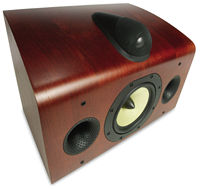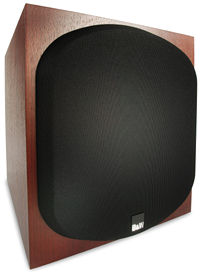B&W 703, HTM7, 705, ASW750 surround speaker system Page 2
B&W also makes a dedicated surround for the 700 series. While I did not review it with this package, the 2-way, sealed-box, four-driver DS7 can be switched between monopole and dipole operation. It has a 6.5-inch woven-Kevlar bass midrange and either a front-mounted, 1-inch alloy dome tweeter (for monopole use) or two side-mounted, 4-inch mid/high-frequency drivers (which replace the dome tweeter when the DS7 is switched to dipole operation).
Doing the 2-Channel
My setup was as usual: The main (703) speakers were positioned about 9 feet apart on either side of my projection screen. They were about 6 feet out from the front (short) wall of my home theater (15.5x26x8 feet) and about 2 feet in front of the projection screen. The HTM7 center speaker was slightly behind the plane of the left and right speakers, on a low stand (actually designed for the B&W Nautilus center) under the screen. The left and right 705 surrounds were mounted on dedicated B&W stands about 7 feet behind the listening position. The ASW750 subwoofer was in the right front corner of the room.
I began my evaluation of the 703 system with music, most of it 2-channel, with only the left and right 703s and the ASW750 sub in operation. But I did disengage the sub briefly and audition the 703s alone, driven full-range. Their sound was open and immediate, with plenty of air and detail. The midrange was exceptionally free of coloration. The balance was a little more forward than is typical of many audiophile speakers, but it was remarkably natural, with bags of unforced detail.
 Driven full-range, the 703s also produced a deep, solid low end. (I left open the ports of all the speakers and did not use the optional foam plugs that B&W supplies to compensate for near-wall placement.) They didn't rattle the teacups, but every time I was about to conclude that the bottom was good to maybe a solid 40Hz but not much lower, along came a surprisingly deep, well-defined passage to prove me wrong by seeming to add at least 10Hz to that estimate.
Driven full-range, the 703s also produced a deep, solid low end. (I left open the ports of all the speakers and did not use the optional foam plugs that B&W supplies to compensate for near-wall placement.) They didn't rattle the teacups, but every time I was about to conclude that the bottom was good to maybe a solid 40Hz but not much lower, along came a surprisingly deep, well-defined passage to prove me wrong by seeming to add at least 10Hz to that estimate.
All of these observations were made with the modest Outlaw 950 pre-pro in the system. With this setup, however, I found that the system's top end sounded just a bit prominent. It wasn't excessively bright or fizzy, but it was nevertheless quite sensitive to and revealing of bright source material. When I switched to the TacT TCS Mk.II pre-pro (currently under evaluation) with its onboard DSP equalization switched off, the top end became noticeably sweeter. The best front end you can afford will not be wasted on the 703s, though they'll still perform well with well-matched, more affordable gear.
Switching in the subwoofer added yet another level of improvement. Two-channel music listeners—or even home theater fans with smaller rooms and an interest mainly in smaller-scale, bass-restricted films—might well be happy with the 703 system sans sub, but there's no question that the subwoofer brought another dimension even to the reproduction of music. The ASW750 went about its business in a crisp, audiophile-like way—much like the ASW675, which I reviewed in September 2003. The ASW750 did go significantly lower than that smaller subwoofer, but it wasn't really a sub-20Hz performer at any substantial playback level. Nevertheless, it significantly enhanced the bass performance of the already fine 703s.
Listening to music on this system was a real pleasure. That lively, open midrange was accompanied by solid imaging and a convincing sense of depth. While I didn't have B&W's flagship 800 Signatures on hand for comparison, I find it hard to imagine how they could provide dramatically better performance. Well, actually, as a hopeless audiophile, I'm sure they can—but I was enjoying the 703-ASW750 listening experience too much to obsess over the possible improvement another $12,000 or so would buy.
Surrounded
I began my movie listening with Ice Age. The bass from the ASW750 subwoofer was not the deepest I've heard in my room, and it was no competition for the best (and far more expensive) subs Keith Yates has been covering in his three-part "Way Down Deep" (the third and final installment of which appears in this issue), but the rumbling glaciers sounded solid and powerful. Considered on its own, the ASW750 didn't seem to be shortchanging anything. More important, it didn't sound boomy or bloated, confirming the audiophile-friendly qualities I noted in my music listening. It blended well with the rest of the system and, with rare exceptions, sounded tight and detailed.
 On Soldier, a film with some of the deepest bass of my thousand or so DVDs, and Star Wars Episode II: Attack of the Clones, the ASW750 sounded just a bit tamer than some of the biggest, most powerful subs I've tried. It didn't quite sound as if it was about to do structural damage to my room, but apart from that, it gave me little cause for complaint. The only material that produced a slightly smeared or boomy sound was high-level explosions, such as those in the battle scene at the climax of Clones. This was at least partly due to room modes. But because this surfaced only at very high playback levels, part of it was certainly caused by driving the sub higher than it liked to go at very low frequencies—particularly in the maximum extension mode (EQ A) I preferred.
On Soldier, a film with some of the deepest bass of my thousand or so DVDs, and Star Wars Episode II: Attack of the Clones, the ASW750 sounded just a bit tamer than some of the biggest, most powerful subs I've tried. It didn't quite sound as if it was about to do structural damage to my room, but apart from that, it gave me little cause for complaint. The only material that produced a slightly smeared or boomy sound was high-level explosions, such as those in the battle scene at the climax of Clones. This was at least partly due to room modes. But because this surfaced only at very high playback levels, part of it was certainly caused by driving the sub higher than it liked to go at very low frequencies—particularly in the maximum extension mode (EQ A) I preferred.
The rest of the system contributed to a remarkably clean, well-integrated, nearly seamless sound. As they went about their surround duties, the 705s called attention to themselves only when something discrete happened in the rear channels—which is as it should be. They never sounded out of place or mismatched to the fronts.
I did notice a slight timbral difference between the center-channel and the main left and right speakers. The HTM7 center sounded a bit more warm and rich, with a trace more coloration, than the 703s. That warmth likely came from my positioning of the center speaker under the screen and closer to the floor than the 703s' midrange drivers. The slight coloration was likely due to the fact that, good as the bass/midrange driver of the HTM7 and 705 is, it isn't as highly refined as the 703's FST midrange driver.
The discontinuity this caused was most evident on pink noise and calibration test tones from the various surround pre-pros I used. It rarely raised its head with real program material, but I'd still like to see a 700-series center speaker with an FST midrange driver. Such a 3-way design would not be out of place with the 703s at the left and right, particularly when you consider the importance of the center channel to movie soundtracks.
As noted earlier, the top end of the 703 system was revealing enough to clearly demonstrate differences in the electronics driving them, but it worked well with all the pre-pros I used. It was slightly brighter and less self-effacing than the smooth, sweet top of the Atlantic Technology System 6200, which I reviewed in the May 2004 Stereophile Guide to Home Theater, but made up for it with a more open and airy, if less forgiving, sound.
Perhaps the characteristic of the 703 system that I most appreciated was its ability to play loud without turning edgy or irritating. This continually surprised and delighted me, as I dropped one explosive, dynamic soundtrack after another into my DVD player. It remained true through the last soundtrack I auditioned before wrapping up this review—The Lord of the Rings: The Return of the King. In only one or two places—in certain string passages in the orchestral score, such as the lighting of the signal fires—did I notice an excessive brightness that I've since heard through other speaker systems as well.
Other Options
With the HTM7 center-channel, B&W got around the problems typical of 2-way center designs by mounting the tweeter above the woofer, much as in a conventional bookshelf speaker such as the 705. If you really want the best system match, however, for a bit more money you might consider using three 703s across the front. This will work only with an acoustically transparent screen, or one mounted high enough to clear the center speaker. I haven't heard such a setup, but it's a system I would otherwise not hesitate to recommend, based on my experience with this one.
Conclusion
The B&W DM 602 S3 system I reviewed in the September 2003 Stereophile Guide to Home Theater was a genuine bargain at $2700. At $6850, the 703 system needs to provide better performance, and it does. It exceeds my recollection of the performance of the DM 602 S3 system in important ways: The highs are smoother and more detailed, the bass deeper, and the midrange—particularly the 703's—is more open and refined. The R&D that B&W has lavished on their statement Nautilus series is paying real dividends in prices that more of us can afford. The 703 system is the latest reflection of that research, and a superb performer.





























































